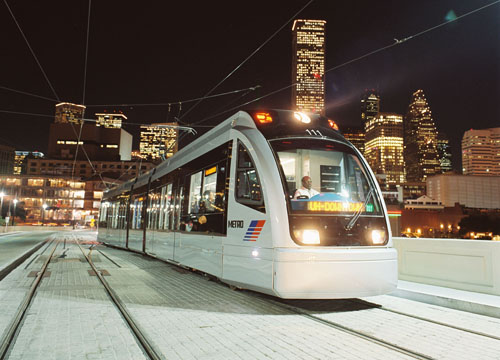
Named after the famed General Sam Houston, former President of the Republic of Texas and the man responsible for commanding and winning the Battle of San Jacinto, the city of Houston was founded back in 1836 and incorporated a year later. Today the city is arguably best recognised as the home of the Lyndon B. Johnson Space Center, itself housing NASA’s Mission Control Center, and with a population of over 2.1 million people is the fourth-largest city in the United States.
Houston, Texas is also the seat of Harris County, the third-most populous county in the country and home to the fifth-largest metropolitan area, with more than six million inhabitants. Servicing this vast population is the Metropolitan Transit Authority of Harris County (METRO). Based in Houston, this major public transportation agency operates the county’s bus, light rail, bus rapid transit and paratransit services, the latter under the name METROLift.
It was in 1973 that Texas State Legislature authorised the creation of local transit authorities in the state. Five years later, Houston-area voters created METRO and approved a one-cent sales tax to support its operations. METRO officially opened for business in January 1979, when it took over the bus service owned by the city, then known as HouTran. Today the authority’s service area encompasses approximately 1,285 square miles and it provides employment for around 3,800 people.
The METRO of 2014 boasts an expansive and heavily used bus system, in fact its bus service is the most used system of its kind in all of Texas and the Southwest. The service also includes the High Occupancy Vehicle (HOV) Park and Ride System, with Park and Ride stations found alongside the city’s freeways and used heavily during peak times.
The METROLift service meanwhile provides transportation needs for people with disabilities and who are unable to board or ride a regular METRO bus. METROLift vehicles are shared ride, transporting multiple customers or groups of individuals in distinctly marked buses.
METRORail, the light rail service operated by METRO currently runs along a single line called the Red Line, which was extended at the end of last year, and will soon expand to include the new East End/Green Line. At 12.8 miles in length the Red Line is the second major light rail service in Texas following the DART system. A fleet of Siemens-built Avanto light rail vehicles operate along the line, each measuring 29 metres in length and with a capacity of 72 seated and 148 standing passengers.
In November 2003, a vote approved the laying of additional rail across Houston, with the plans for the expansion of the METRORail system undergoing several revisions in the years that followed. All planned expansions exist within Houston’s city limits and are expected to ultimately reach the cities two major airports, George Bush International Airport and William P. Hobby Airport. Further down the line it is the authority’s intention to roll out further expansions to the network that will service many of Houston’s well populated suburbs.
At the heart of METRO’s growth plans for the future is its large transportation and infrastructure plan, dubbed METRO Solutions, which it expects to have complete by 2020. The plan calls for a number of advances to Houston’s transportation network, including 30 miles of Light Rail Transit. This will be made up of the University Line from Hillcroft to the University of Houston, Texas Southern University, and eventually the city’s Eastwood Transit Center. Light Rail plans that fall under the METRO Solutions plan also includes the aforementioned extension of the Red Line and creation of the proposed Southeast, East End and Uptown Lines.
METRO Solutions’ plans also call for 28 miles of Commuter Rail Transit (CRT) to be introduced in and around the city, the introduction of 40 miles worth of Signature Bus Service/Suburban Bus Rapid Transit routes, the building of ten new transit facilities, including five transit hubs and four Park and Ride lots, and further conversions of roads and highways to transform them into dedicated HOV lanes.
All of this has and will continue to require a massive amount of work, however the needs of the city requires it, and these needs are simple. Findings commissioned by METRO indicate that the population of Houston has the potential to increase by up to 3.5 million people by 2030. The need to design, construct and open new transportation infrastructure is very real and is a puzzle that METRO is taking the initiative on solving.
Written by Will Daynes, research by David Brogan



 MetroHouston-Americas-T&L-Jun14-Bro-s.pdf
MetroHouston-Americas-T&L-Jun14-Bro-s.pdf









